Lecture notes written by Albert Jacka VC
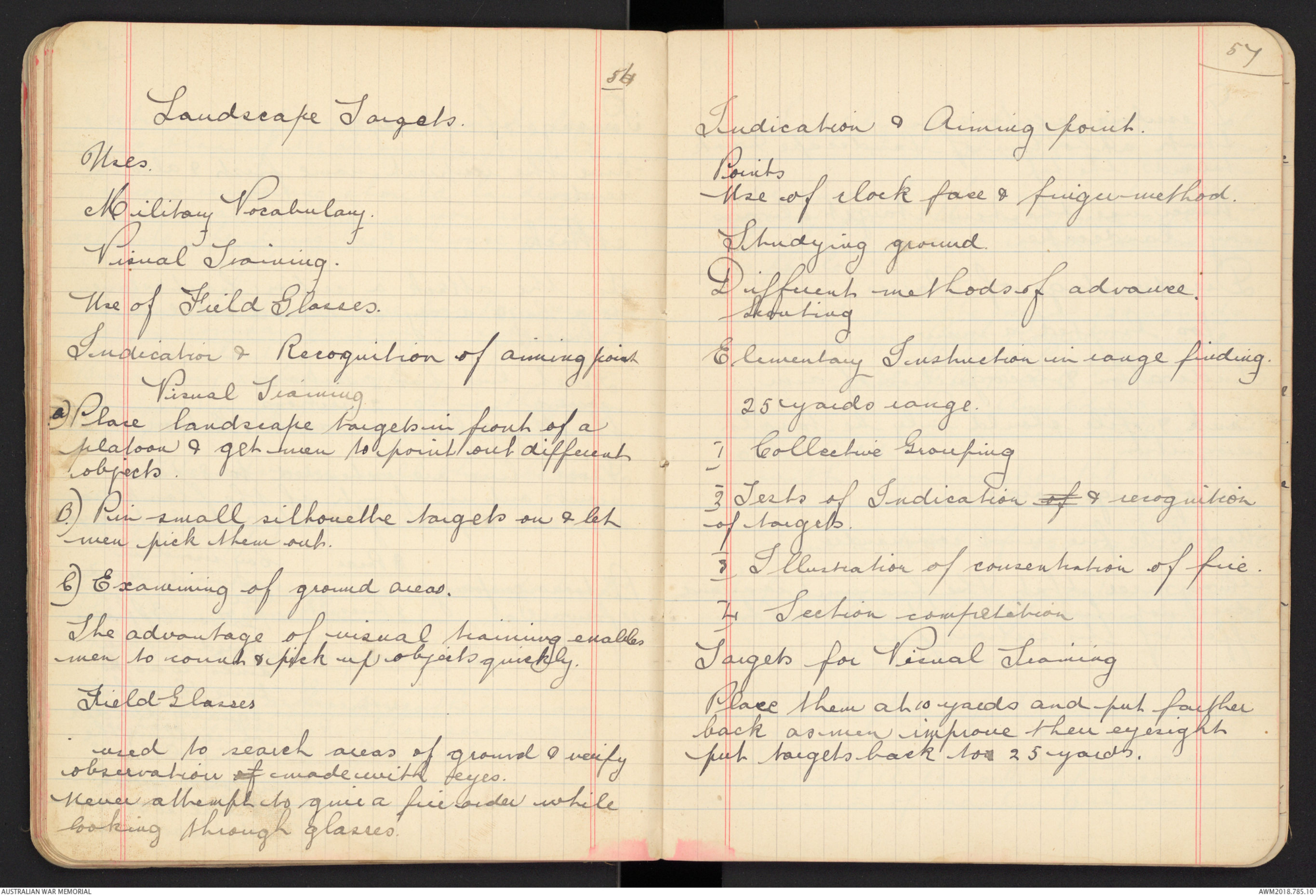
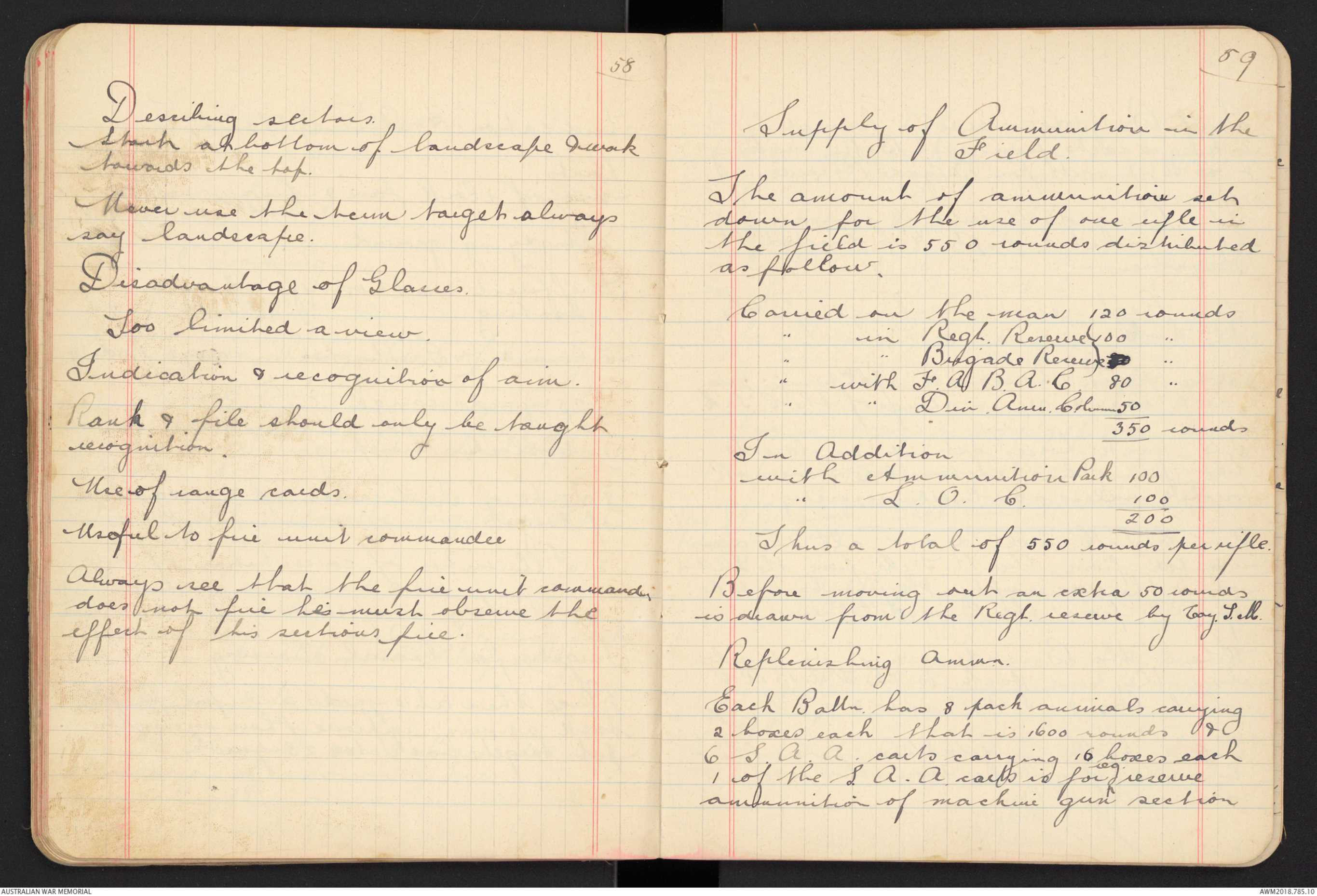
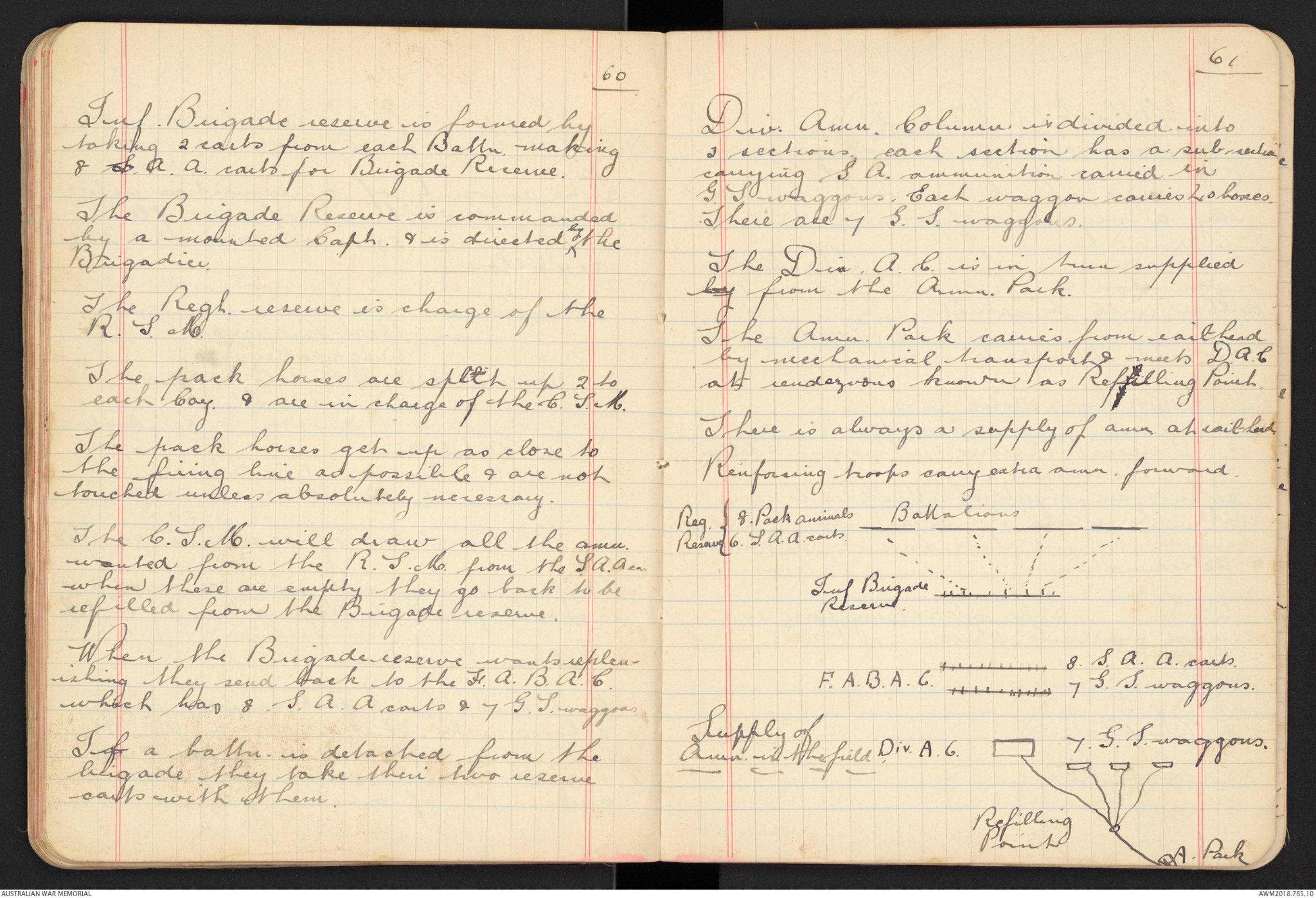
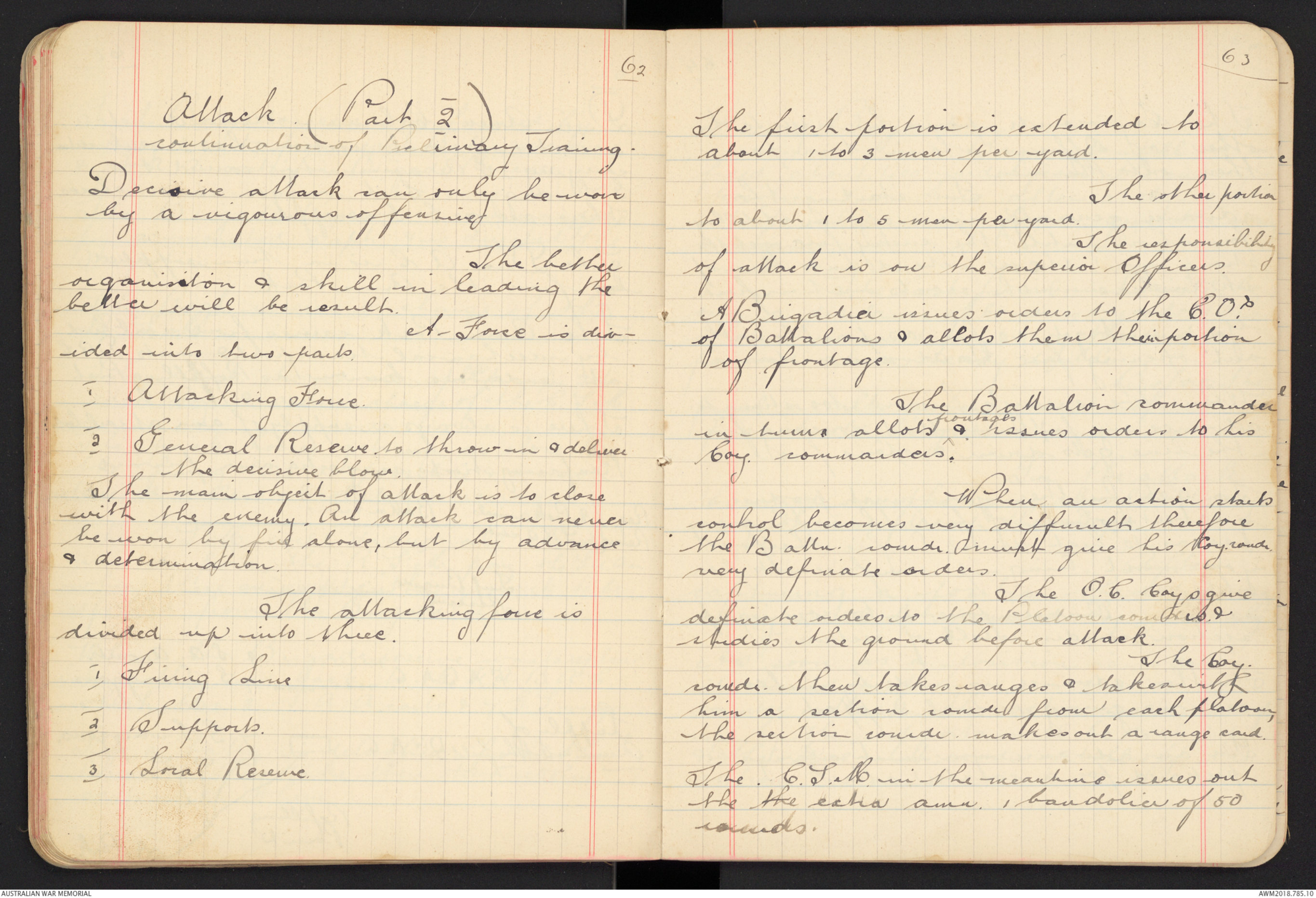
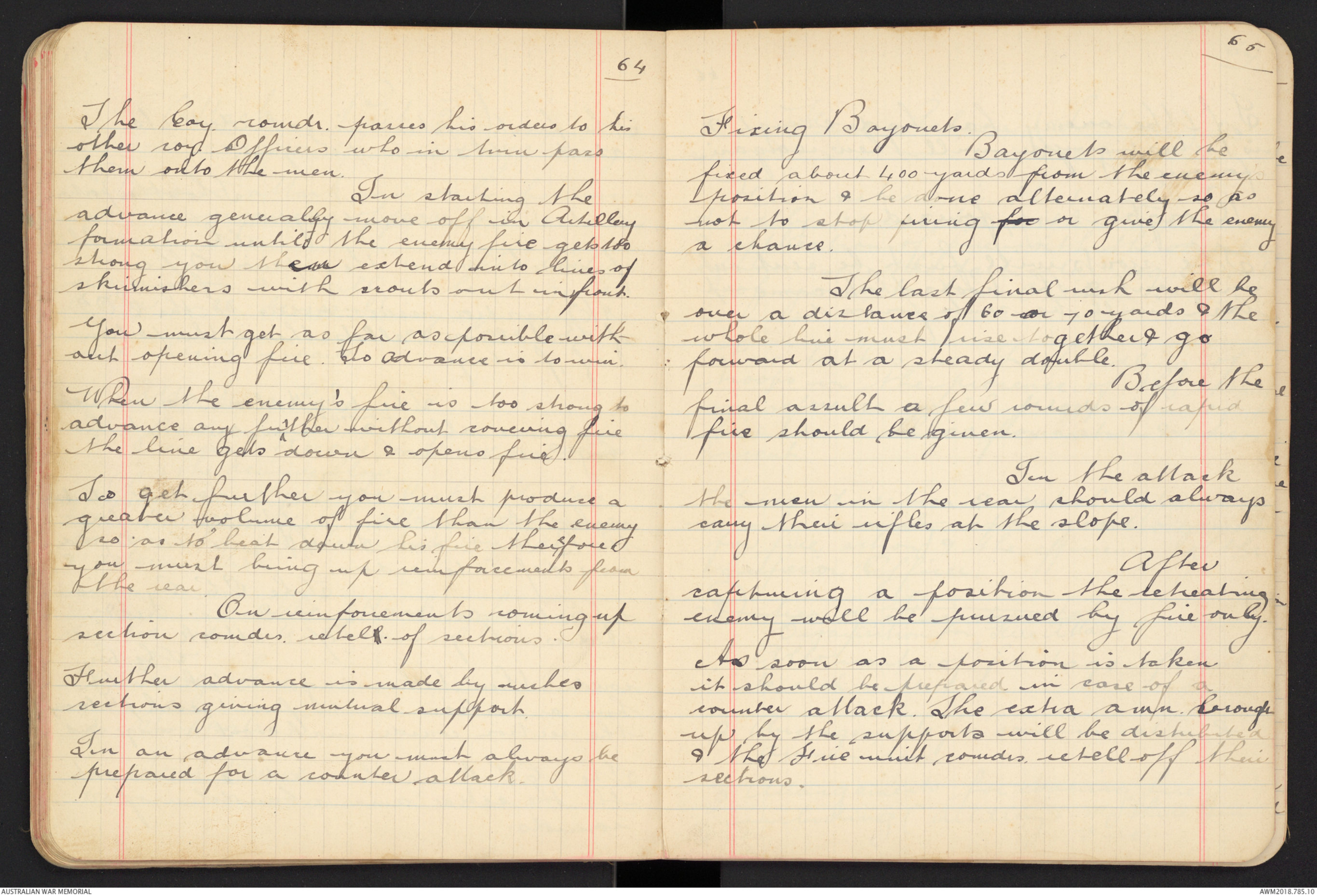
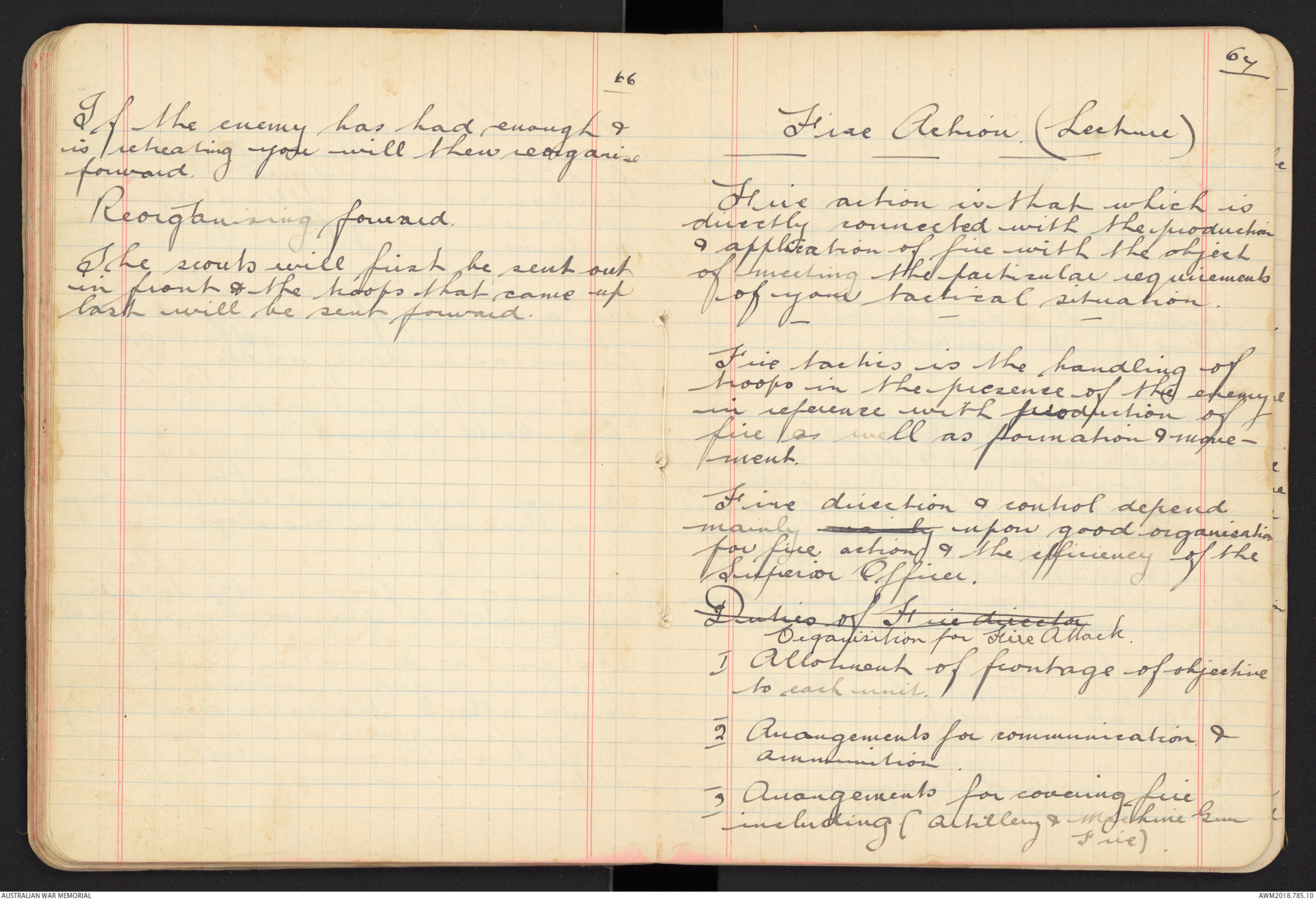
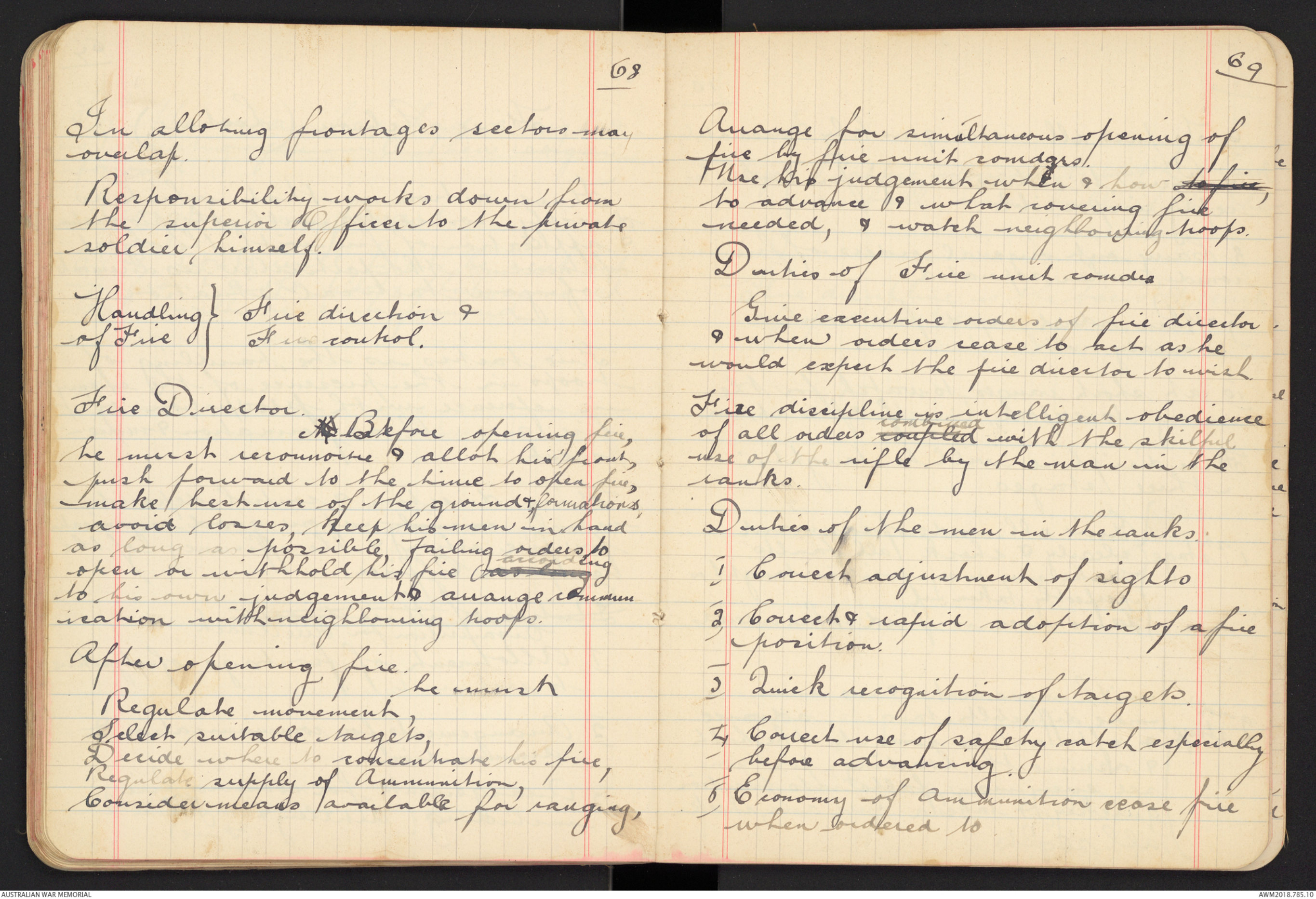
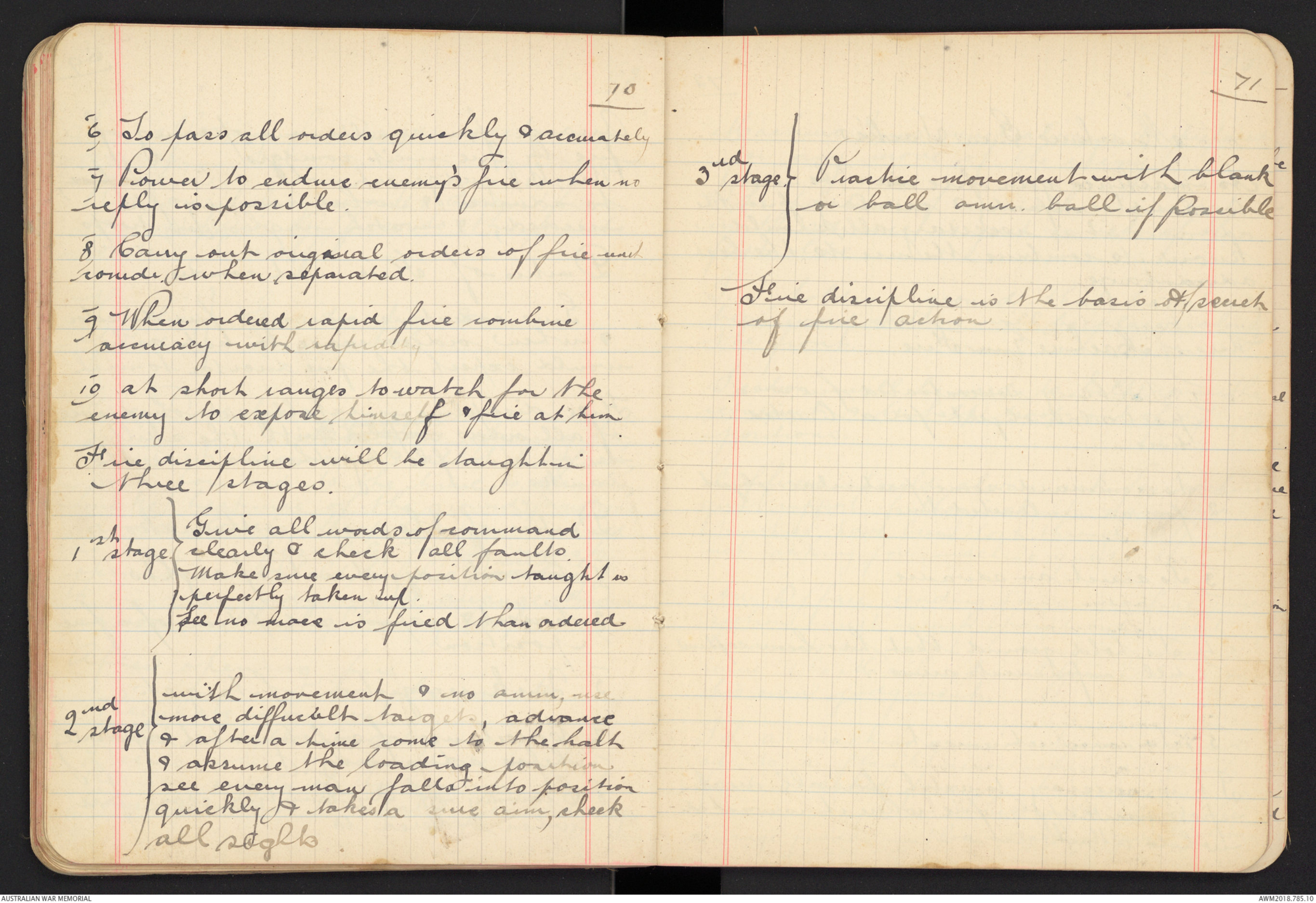
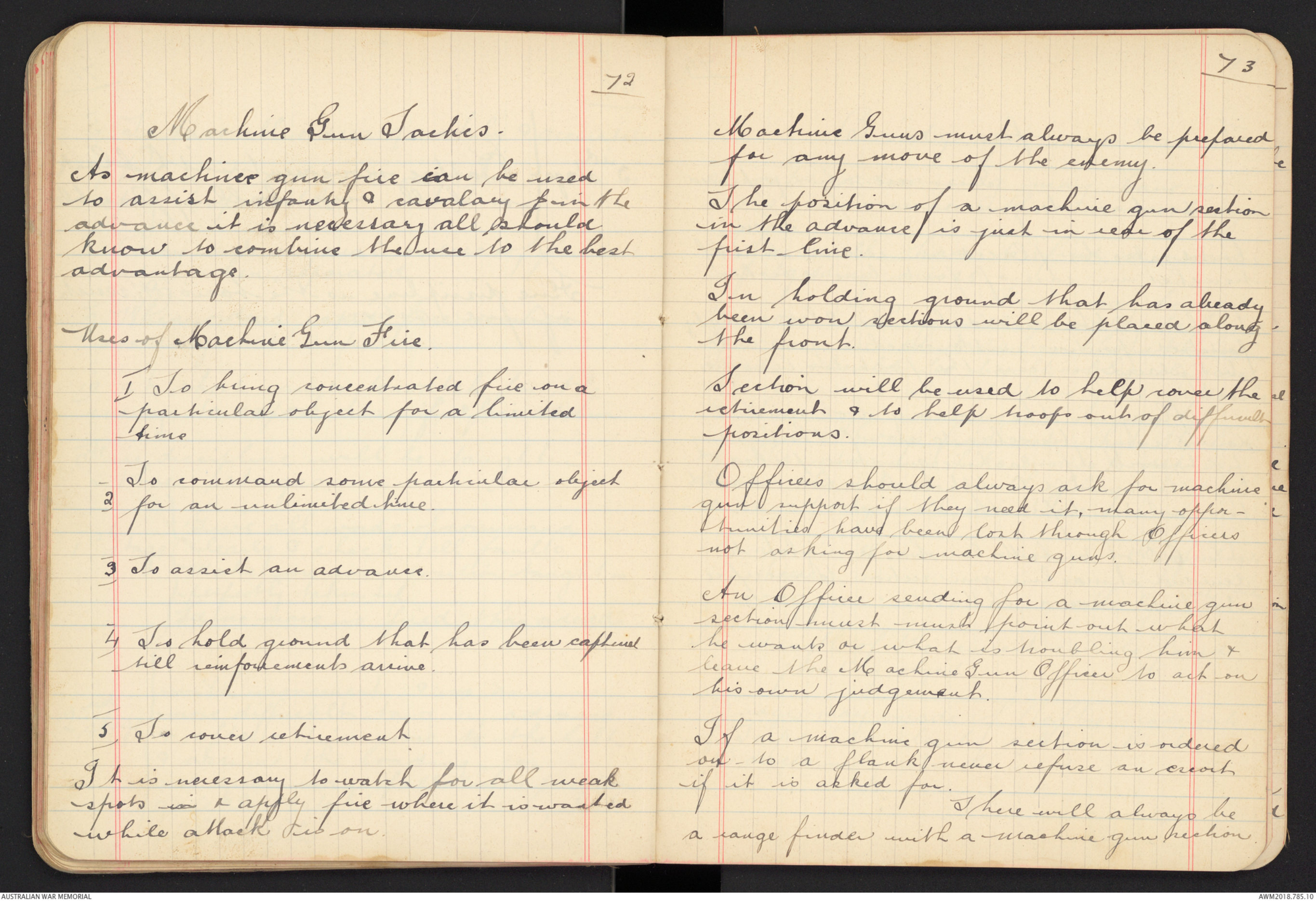
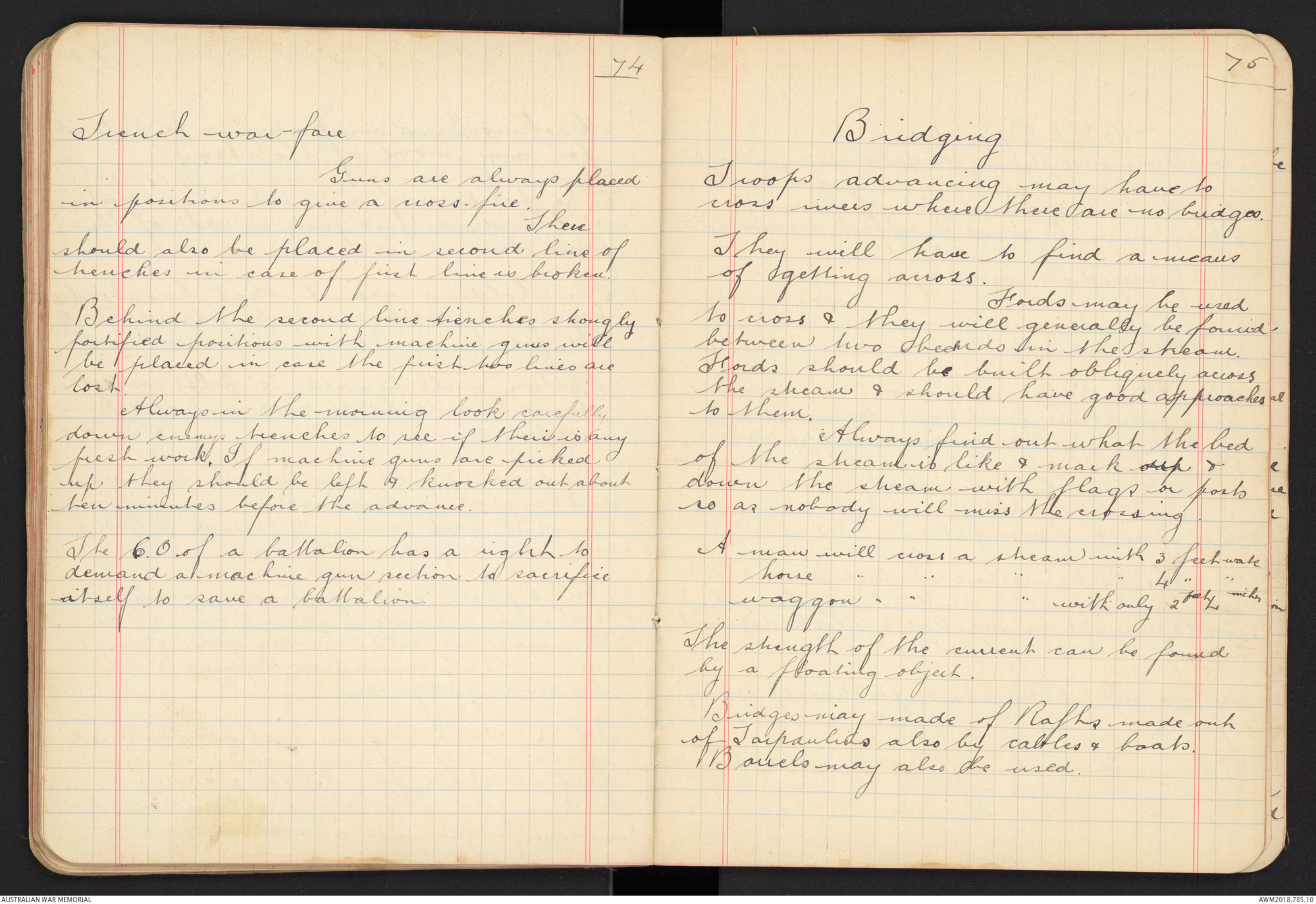
56
Landscape Targets
Uses.
Military Vocabulary.
Visual Training.
Use of Field Glasses.
Indication & Recognition of aiming point
Visual Training
a) Place landscape targets in front of a
platoon & get men to point out different
objects.
B.) Pin small silhouette targets on & let
men pick them out.
C) Examining of ground areas.
The advantage of visual training enables
men to count & pick up objects quickly.
Field Glasses
used to search areas of ground & verify
observation of made with eyes.
Never attempt to give a fire order while
looking through glasses.
57
Indication & Aiming point.
Points
Use of clock face & finger-method
Studying ground.
Different methods of advance
Scouting
Elementary Instruction in range finding.
25 yards range.
1 Collective Grouping
2 Tests of Indication of & recognition
of targets
3 Illustration of consentration of fire.
4 Section competition
Targets for Visual Training
Place them at 10 yards and put farther
back as men improve their eyesight
put targets back too 25 yards.
58
Describing sectors.
Start at bottom of landscape & work
towards the top.
Never use the term targets always
say landscape.
Disadvantage of Glasses.
Too limited a view.
Indication & recognition of aim.
Rank & file should only be taught
recognition.
Use of range cards.
Useful to fire unit commander
Always see that the fire unit commander
does not fire he must observe the
effect of his sections fire.
59
Supply of Ammunition in the
Field.
The amount of ammunition set
down for the use of one rifle in
the field is 550 rounds distributed
as follow.
Carried on the man 120 rounds
" in Regt. Reserves ) 100 "
" " Brigade Reserve ) 80 "
" with F.A.B.A.C. 80 "
" " Div. Am. Column 50
350 rounds
In Addition
with Ammunition Pack 100
" L.O.C. 100
200
Thus a total of 550 rounds per rifle.
Before moving out an extra 50 rounds
is drawn from the Regt. reserve by Coy. S.M.
Replenishing Ammn.
Each Battn has 8 pack animals carrying
2 boxes each that is 1600 rounds &
6 S.A.A. carts carrying 16 boxes each
1 of the S.A.A. carts is for^reg. reserve
ammunition of machine gun section
60
Inf. Brigade reserve is formed by
taking 2 carts from each Battn. making
8 S.A.A. carts for Brigadier Reserve.
The Brigade Reserve is commanded
by a mounted Capt. & is directed ^by the
Brigadier.
The Regt. reserve is charge of the
R.S.M.
The pack horses are split up 2 to
each Coy. & are in charge of the C.S.M.
The pack horses get up as close to
the firing line as possible & are not
touched unless absolutely necessary.
The C.S.M. will draw all the amm.
wanted from the R.S.M. from the S.A.A car
when these are empty they go back to be
refilled from the Brigade reserve.
When the Brigade reserve wants replenishing
they send back to the F.A.B.A.C.
which has 8 S.A.A carts & 7 G.S. waggons.
If a battn. is detached from the
brigade they take their two reserve
carts with them.
61
Div. Amn. Column is divided into
2 sections each section has a sub-section
carrying S.A. ammunition carried in
G.S waggons. Each waggon carries 20 boxes.
There are 7 G.S. waggons.
The Div. A.C. is in turn supplied
by from the Amn. Park.
The Amn. Park carries from rail-head
by mechanical transport & meets D.A.C.
at rendezvous known as Reffilling Point.
There is always a supply of amn. at rail-head.
Reinforcing troops carry extra amn. forward.
Reg. ( 8. Pack animals
Reserve ( 6. S.A.A. carts
Diagram - see original document
62
Attack (Part 2)
continuation of Preliminary Training.
Decisive attack can only be won
by a vigorous offensive.
The better
organisation & skill in leading the
better will be result.
A Force is divided
into two parts.
1 Attacking Force
2 General Reserve to throw in & deliver
the decisive blow.
The main object of attack is to close
with the enemy. An attack can never
be won by fire alone, but by advance
& determination.
The attacking force is
divided up into three.
1 Firing Line
2 Supports.
3 Local Reserve
63
The first portion is extended to
about 1 to 3 men per yard.
The other portion
to about 1 to 5 men per yard.
The responsibility
of attack is on the superior Officers.
A Brigadier issues orders to the C.O.s
of Battalions & allots them their portion
of frontage.
The Battalion commander
in turn allots ^frontages & issues orders to his
Coy. commanders.
When an action starts
control becomes very difficult therefore
the Battn. comdr. must give his Coy. comdr.
very definate orders.
The O.C. Coys give
definate orders to the Platoon comdrs. &
studies the ground before attack.
The Coy.
comdr. then takes ranges & takes with
him a section comdr from each platoon,
the section comdr. makes out a range card.
The C.S.M. in the meantime issues out
the the extra amn. 1 bandolier of 50
rounds.
64
The Coy. comdr. passes his orders to his
other coy. Officers who in turn pass
them onto the men.
In starting the
advance generally move off in Artillery
formation until the enemy fire gets too
strong you then extend into lines of
skirmishers with scouts out in front.
You must get as far as possible without
opening fire. To advance is to win.
When the enemy's fire is too strong to
advance any fu^rther without covering fire
the line gets down & opens fire.
To get further you must produce a
greater volume of fire then the enemy
so as to beat down his fire therefore
you must bring up reinforcements from
the rear.
On reinforcements coming up
section comdrs. retell of sections.
Further advance is made by rushes
sections giving mutual support.
In an advance you must always be
prepared for a counter attack.
65
Fixing Bayonets.
Bayonets will be
fixed about 400 yards from the enemy's
position & be done alternately so as
not to stop firing for or give the enemy
a chance.
The last final rush will be
over a distance of 60 or 70 yards & the
whole line must rise together & go
forward at a steady double.
Before the
final assault a few rounds of rapid
fire should be given.
In the attack
the men in the rear should always
carry their rifles at the slope.
After
capturing a position the retreating
enemy will be pursued by fire only.
As soon as a position is taken
it should be prepared in case of a
counter attack. The extra amm. brought
up by the supports will be distributed
& the Fire unit comdrs. retell off their
sections.
66
If the enemy has had enough &
is retreating you will then reorganise
forward.
Reorganising forward.
The scouts will first be sent out
in front & the troops that came up
last will be sent forward.
67
Fire Action (Lecture)
Fire action is that which is
directly connected with the production
& application of fire with the object
of meeting the particular requirements
of your tactical situation.
Fire tactics is the handling of
troops in the presence of the enemy
in reference with production of
fire as well as formation & movement.
Fire direction & control depend
mainly mainly upon good organisation
for fire action & the efficiency of the
Superior Officer.
Duties of Fire Direction
Organisation for Fire Attack.
1 Allotment of frontage of objective
to each unit.
2 Arrangements for communication &
ammunition.
3 Arrangements for covering fire
including (Artillery & Machine Gun
Fire).
68
In alloting frontages sectors may
overlap.
Responsibility works down from
the superior Officer to the private
soldier hmself.
Handling ) Fire direction &
of Fire ) Fire control.
Fire Director.
M Before opening fire,
he must reconnoitre & allot his front,
push forward to the Line to open fire,
make best use of the ground & formations,
avoid losses, keep his men in hand
as long as possible, failing orders to
open or withhold his fire (as long according
to his own judgement & arrange communication
with neighbouring troops.
After opening fire.
he must
Regulate movement,
Select suitable targets,
Decide where to concentrate his fire,
Regulate supply of Ammunition,
Consider means available for ranging,
69
Arrange for simultaneous opening of
fire by fire unit comdrs.
Use his judgement when & how to fire,
to advance & what covering fire
needed, & watch neighbouring troops.
Duties of Fire unit comdrs.
Give executive orders of fire director
& when orders cease to act as he
would expect the fire director to wish.
Fire discipline is intelligent obedience
of all orders coupled combined with the skilful
use of the rifle by the man in the
ranks.
Duties of the men in the ranks.
1 Correct adjustment of sights
2 Correct & rapid adoption of a fire
position.
3 Quick recognition of targets.
4 Correct use of safety catch especially
before advancing.
5 Economy of Ammunition cease fire
when ordered to.
70
6 To pass all orders quickly & accurately
7 Power to endure enemy's fire when no
reply is possible.
8 Carry out original orders of fire unit
comdr. when separated.
9 When ordered rapid fire combine
accuracy with rapidity
10 at short ranges to watch for the
enemy to expose himself & fire at him
Fire discipline will be taught in
three stages.
1st stage Give all words of command
clearly & check all faults.
Make sure every position taught is
perfectly taken up.
See no more is fired than ordered.
2nd stage with movement & no amm, use
more difficult targets, advance
& after a time come to the halt
& assume the loading position
see every man falls into position
quickly & takes a sure aim, check
all sights.
71
3rd stage Practice movement with blank
or ball amn. ball if possible
Fire discipline is the basis & secret
of fire action
72
Machine Gun Tactics.
As machine gun fire can be used
to assist infantry & cavalry f in the
advance it is necessary all should
know to combine the use to the best
advantage.
Uses of Machine Gun Fire.
1 To bring concentrated fire on a
particular object for a limited
time
2 To command some particular object
for an unlimited time.
3 To assist an advance.
4 To hold ground that has been captured
till reinforcements arrive.
5 To cover retirement.
It is necessary to watch for all weak
spots in & apply fire where it is wanted
while attack is on.
73
Machine Guns must always be prepared
for any move of the enemy.
The position of a machine gun section
in the advance is just in rear of the
first line.
In holding ground that has already
been won sections will be placed along
the front.
Section will be used to help cover the
retirement & to help troops out of difficult
positions.
Officers should always ask for machine
gun support if they need it, many opportunities
have been lost through Officers
not asking for machine guns.
An Officer sending for a machine gun
section must must point out what
he wants or what is troubling him &
leave the Machine Gun Officer to act on
his own judgement.
If a machine gun section is ordered
on-to a flank never refuse an escort
if it is asked for.
There will always be
a range finder with a machine gun section.
74
Trench war-fare
Guns are always placed
in positions to give a cross-fire.
These
should also be placed in second line of
trenches in case of first line is broken.
Behind the second line trenches strongly
fortified positions with machine guns will
be placed in case the first two lines are
lost.
Always in the morning look carefully
down enemys trenches to see if their is any
fresh work. If machine guns are picked
up they should be left & knocked out about
ten minutes before the advance.
The C.O. of a battalion has a right to
demand a machine gun section to sacrifice
itself to save a battalion.
75
Bridging
Troops advancing may have to
cross rivers where there are no bridges.
They will have to find a means
of getting across.
Fords may be used
to cross & they will generally be found
between two bends in the stream.
Fords should be built obliquely across
the stream & should have good approaches
to them.
Always find-out what the bed
of the stream is like & mark up &
down the stream with flags or posts
so as nobody will miss the crossing.
A man will cross a stream with 3 feet water
horse " " " " 4 " "
waggon " " " with only 2 feet 4 inches
The strength of the current can be found
by a floating object.
Bridges may made of Rafts made out
of Tarpaulins also by cables & boats.
Barrels may also be used.
 Sam scott
Sam scottThis transcription item is now locked to you for editing. To release the lock either Save your changes or Cancel.
This lock will be automatically released after 60 minutes of inactivity.